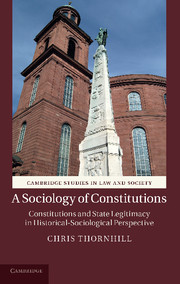 A Sociology of Constitutions
A Sociology of Constitutions Book contents
- Frontmatter
- Contents
- Acknowledgements
- A note on texts and translations
- Introduction
- 1 Medieval constitutions
- 2 Constitutions and early modernity
- 3 States, rights and the revolutionary form of power
- 4 Constitutions from empire to fascism
- 5 Constitutions and democratic transitions
- Conclusion
- Bibliography
- Index
3 - States, rights and the revolutionary form of power
Published online by Cambridge University Press: 07 September 2011
- Frontmatter
- Contents
- Acknowledgements
- A note on texts and translations
- Introduction
- 1 Medieval constitutions
- 2 Constitutions and early modernity
- 3 States, rights and the revolutionary form of power
- 4 Constitutions from empire to fascism
- 5 Constitutions and democratic transitions
- Conclusion
- Bibliography
- Index
Summary
The progressive formation of sovereign states in many European societies in the sixteenth and seventeenth centuries was part of a substantial transformation in the basic structure and application of political power, which saw an increase in the volume of power and the mass of political decisions required by different societies. Indeed, the formation of states reflected a process in which power became political power in the modern sense of the word: it constructed power as a resource that was relatively indifferent to singular persons, that was not fully reliant on direct conflict or coercion for its usage, and that contained a positive internal structure which allowed it to be applied inclusively and reproduced across significant structural, regional and temporal variations in particular societies. The construction of states, beginning with the disruption of feudalism in the high Middle Ages, is widely viewed in historical-theoretical literature as a process of concerted expropriation, in which regents, in order to heighten their extractive force, coercively eliminated all intermediary authorities between themselves and those subject to power. However, the primary feature of this process was not, in fact, that power was applied more coercively or became more forceful. On the contrary, this process meant that power was refined as a differentiated social object, that it was utilized in increasingly constant procedures, and that it was defined and applied in legal formulae that could be used, in internally replicable manner, to regulate very different questions across wide social boundaries. This had the result, in turn, that power was transmitted to all social agents in increasingly uniform and inclusive fashion: through its internal transformation, power constructed its societal addressees at a growing level of inner consistency and legal uniformity. This of course does not mean that European states were fully formed by the seventeenth century.
- Type
- Chapter
- Information
- A Sociology of ConstitutionsConstitutions and State Legitimacy in Historical-Sociological Perspective, pp. 158 - 251Publisher: Cambridge University PressPrint publication year: 2011
